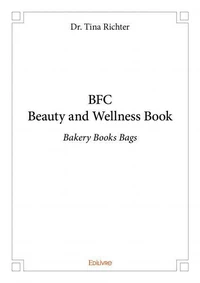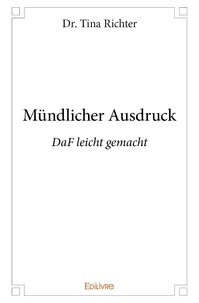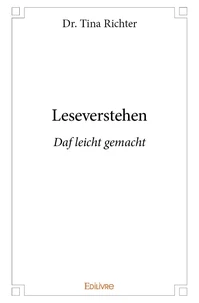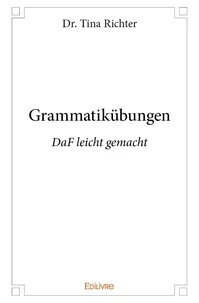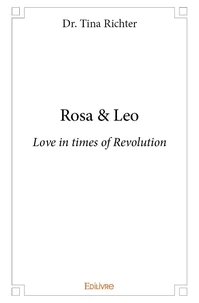Professeur de l'Éducation nationale, certifiée d'allemand, Dr. Tina Richter a obtenu un doctorat de l'université de Strasbourg, et elle est également traductrice agrégée et auteure de plusieurs ouvrages sur l'histoire et la cuisine de l'Allemagne, sur l'enseignement de l'allemand ainsi que d'une thèse sur les stéréotypes en RFA et en RDA. Née en 1981 en Allemagne du Sud, fille de professeur et petite-fille de cuisinier, elle est naturalisée française en 2008 et obtient un diplôme de psychologie générale en 2009 et un master de l'université de Strasbourg en 2010. Aujourd'hui, elle vit et travaille en Allemagne du Sud comme professeur, auteure et traductrice.
Schiller, the daughter of freedom. A free adaption of the life of Friedrich Schiller (1759 – 1805), the most famous european playright after William Shakespeare Novel
Par :Formats :
- Paiement en ligne :
- Livraison à domicile ou en point Mondial Relay indisponible
- Retrait Click and Collect en magasin gratuit
- Nombre de pages90
- PrésentationBroché
- Poids0.1184 kg
- Dimensions13,4 cm × 20,4 cm × 0,7 cm
- ISBN978-2-334-11915-3
- EAN9782334119153
- Date de parution10/06/2016
- CollectionClassique
- ÉditeurEdilivre
Résumé
How was the private life of the most famous German playwright ? Where did Friedrich Schiller find the necessary energy to write his dramas, and poems ? Where did he found the inspiration for his idea about Beauty ? What was the influence of his marriage, and his love to Charlotte von Lengefeld ? To answer this question, this novel is based on the life of Friedrich Schiller with a focus on the years from 1787 to 1794, but going until Schiller's death in 1805.
It is a free adaption of Schiller's life, taking the events of his life as a general background, and filling them with narrative fictive elements. The story and tells you the story of Friedrich Schiller and Charlotte von Lengefeld. Our story starts in 1787, and ends with Schiller's death in 1805. For narrative reasons, we settle the first meeting of Charlotte and Friedrich not in 1785, as it was in reality, but in the year 1788.
We call our Story "Beauty" because of the Theory of Beauty Schiller established in 1794, serving as a literary background of our writing. The goal of our story is not to give a simple biography of Schiller's life, but to fill up the biographical facts with love, life, and narrative elements, so that the famous playwright becomes an entire character, and his life not only a series of events, but a life with feelings and fears.
We want to present a delighted, and positive image of Schiller, close to reality, but filled up with narrative elements making a film adaption possible, and creating an everlasting effect on the audience. The events in Schiller's life serve as a biographical background which is filled up with narrative and fictive elements to make the lecture fluently and a film adaptation possible.
It is a free adaption of Schiller's life, taking the events of his life as a general background, and filling them with narrative fictive elements. The story and tells you the story of Friedrich Schiller and Charlotte von Lengefeld. Our story starts in 1787, and ends with Schiller's death in 1805. For narrative reasons, we settle the first meeting of Charlotte and Friedrich not in 1785, as it was in reality, but in the year 1788.
We call our Story "Beauty" because of the Theory of Beauty Schiller established in 1794, serving as a literary background of our writing. The goal of our story is not to give a simple biography of Schiller's life, but to fill up the biographical facts with love, life, and narrative elements, so that the famous playwright becomes an entire character, and his life not only a series of events, but a life with feelings and fears.
We want to present a delighted, and positive image of Schiller, close to reality, but filled up with narrative elements making a film adaption possible, and creating an everlasting effect on the audience. The events in Schiller's life serve as a biographical background which is filled up with narrative and fictive elements to make the lecture fluently and a film adaptation possible.
How was the private life of the most famous German playwright ? Where did Friedrich Schiller find the necessary energy to write his dramas, and poems ? Where did he found the inspiration for his idea about Beauty ? What was the influence of his marriage, and his love to Charlotte von Lengefeld ? To answer this question, this novel is based on the life of Friedrich Schiller with a focus on the years from 1787 to 1794, but going until Schiller's death in 1805.
It is a free adaption of Schiller's life, taking the events of his life as a general background, and filling them with narrative fictive elements. The story and tells you the story of Friedrich Schiller and Charlotte von Lengefeld. Our story starts in 1787, and ends with Schiller's death in 1805. For narrative reasons, we settle the first meeting of Charlotte and Friedrich not in 1785, as it was in reality, but in the year 1788.
We call our Story "Beauty" because of the Theory of Beauty Schiller established in 1794, serving as a literary background of our writing. The goal of our story is not to give a simple biography of Schiller's life, but to fill up the biographical facts with love, life, and narrative elements, so that the famous playwright becomes an entire character, and his life not only a series of events, but a life with feelings and fears.
We want to present a delighted, and positive image of Schiller, close to reality, but filled up with narrative elements making a film adaption possible, and creating an everlasting effect on the audience. The events in Schiller's life serve as a biographical background which is filled up with narrative and fictive elements to make the lecture fluently and a film adaptation possible.
It is a free adaption of Schiller's life, taking the events of his life as a general background, and filling them with narrative fictive elements. The story and tells you the story of Friedrich Schiller and Charlotte von Lengefeld. Our story starts in 1787, and ends with Schiller's death in 1805. For narrative reasons, we settle the first meeting of Charlotte and Friedrich not in 1785, as it was in reality, but in the year 1788.
We call our Story "Beauty" because of the Theory of Beauty Schiller established in 1794, serving as a literary background of our writing. The goal of our story is not to give a simple biography of Schiller's life, but to fill up the biographical facts with love, life, and narrative elements, so that the famous playwright becomes an entire character, and his life not only a series of events, but a life with feelings and fears.
We want to present a delighted, and positive image of Schiller, close to reality, but filled up with narrative elements making a film adaption possible, and creating an everlasting effect on the audience. The events in Schiller's life serve as a biographical background which is filled up with narrative and fictive elements to make the lecture fluently and a film adaptation possible.


